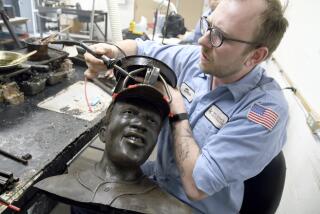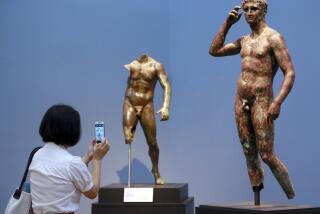Cracking the ‘Kouros’ Case : Getty Gets First Look at Known Fake in Attempt to Authenticate Prized Statue
- Share via
The J. Paul Getty Museum has launched an extensive examination of its prized “Kouros,” a 6-foot, 8-inch-tall marble sculpture of a nude young man. Thought to be a rare 6th-Century BC Greek statue, the sculpture has been prominently displayed as one of the museum’s three most valued antiquities, along with a marble “Aphrodite” and a bronze “Victorious Athlete.”
But a fake archaic torso, recently discovered in Switzerland, has cast doubt on the figure’s authenticity, leading the museum to remove the “Kouros” last week and purchase the fake for study purposes. The torso arrived in Malibu on Thursday, in preparation for an examination that is expected to continue for several months and involve experts at the museum, the Getty Conservation Institute and independent laboratories.
Marion True, the Getty’s curator of antiquities, will conduct a stylistic analysis of the two statues, while antiquities conservator Jerry Podany and Getty scientists investigate the stone, surface deposits and other physical properties. They hope to arrive at a conclusion about a statue that has already been extensively studied but has continued to present puzzling questions to scholars.
“At this point, anything is possible. We just don’t know what we will find,” said Podany, who studied the sculpture before the museum bought it in 1985 and conducted further examinations before the statue went on display in 1986. The museum reportedly purchased the piece for more than $6 million from a Swiss dealer acting on behalf of a private collector. In the new investigation, curators, conservators and scientists will weigh every scrap of evidence on both sides of the question and “form an opinion based on the weightiest end of the two columns,” he said.
“It was disappointing to see the ‘Kouros’ come down, but beyond that, there’s real excitement in the opportunity to get close to a more firm truth. We don’t have the luxury to want it to be resolved one way or the other,” Podany said.
The 1,100-pound marble statue that once stood tall in a distinguished collection has been struck down--at least temporarily--by an imitation archaic Greek torso. Since buying the piece the Getty has learned that it was probably made in the early 1980s in Rome and that it was crafted as an intentional forgery. It is said to have been unsuccessfully offered to several collectors before the Getty got wind of it.
The Getty has also discovered that the torso is only the central fragment of a larger sculpture--and probably a last ditch effort to pass the piece off as the real thing. In earlier incarnations, the torso is known to have had a head, but apparently that was lopped off when it was thought to be too obvious a forgery. Now that the Getty has gone public with its investigation, True and Podany said that they wouldn’t be surprised if other parts of the forgery were brought to their attention.
The torso might never have found a respectable home if an anonymous “friend of the museum” hadn’t seen it and told True about its existence. The call came late in April, just as she was leaving for Athens to give a lecture, True said, so she quickly made arrangements to see the piece in Switzerland during her trip. She wasn’t allowed to photograph the sculpture and light was poor in the Basel port facility where the torso was stored, but she was sufficiently concerned about apparent similarities to send for Podany.
“I felt like someone had kicked me when I first saw it. I wasn’t prepared for it, even though the person who told me about it is someone I respect,” True said.
Most casual viewers would not understand why True was troubled. The torso is roughly two-thirds the scale of the Getty’s complete figure and the workmanship is comparatively crude. A nasty brown surface--the result of an attempt to artificially age the piece by boiling it in acid--contrasts sharply with the glowing, off-white surface of the “Kouros.”
What True saw beneath the grime were stylistic qualities similar to those of the “Kouros.” These characteristics were all the more disturbing because they seemed to correspond to anomalies in the “Kouros” that have subjected it to scholarly debate over the years.
Looking over the torso shortly after it was unpacked in Malibu, True pointed out “narrow, sloping shoulders” that differ from other “Kouros” figures. Both sculptures have “insensitively carved” hands with straight cuts separating the fingers, they lack a feeling of “internal structure” in the wrist area and the carving appears soft in the upper arms, she said.
While in Athens, True re-examined familiar “Kouros” figures to see if these features turned up in pieces that have long been accepted as authentic, but she observed that the Getty figure and the torso seemed to have more in common with each other than with the statues in Greece.
After their initial trip to see the torso, True and Podany returned to Malibu and presented their findings to the board of directors. In mid-June, they went back to Basel with small plaster castings of parts of the “Kouros” that included stylistic details and evidence of tool work. They compared castings of the hands, collar bone, abdomen and navel, groin area and grooves between the arms and the chest with similar parts of the the torso. Podany also took a tiny sample of marble from the torso and found that the two sculptures were made of the same kind of stone, possibly from the same quarry on the Island of Thasos.
True’s informant had indicated that the two statues might have been created in the same studio and possibly from the same block of stone. Though the antiquities trade is notoriously subject to implausible rumors, True and Podany said that no possibility could be overlooked. In this case, the sample of stone lent credence to the theory that the two sculptures were closely connected. Persuaded that the museum needed to own the torso to conduct a serious, in-house study, Podany and True got the board’s permission to buy the piece. True made a third trip to Basel last week to arrange for transport.
Preliminary findings don’t appear to bode well for the Getty, but Podany and True point out that there are as many differences as similarities between the two pieces. True said her concerns were only “visual reactions” that might be disproved or mitigated by scientific findings. Perhaps the most persuasive evidence in favor of authenticity is that tests conducted five years ago on the “Kouros” indicated that the surface crust had been created naturally over a long period of time. Scientists know of no way to duplicate that surface artificially, but even that conclusion will be reconsidered, Podany said.
“We don’t think a forger could create that surface intentionally, but we have to look into the possibility that it was done accidentally. We have tried a lot of things, but so far nothing has come close,” he said.
The Getty is just beginning to plan its strategy for examining the sculptures, Podany said. Among first steps, he and other scientists will determine the elemental composition of the torso’s marble, including trace elements, and measure the size and orientation of the grain. To do this, he will take tiny samples from both sculptures. As in past studies, data will be analyzed at the Getty and at two or more independent labs for the sake of comparison and accuracy.
A full-scale, accurate reproduction of the torso will be made in plaster because the dark crust is “distracting,” Podany said. In addition, the torso’s surface will be replicated on a similar piece of stone.
Unwelcome as it may be, the forgery has real historical value, True said. In the uncertain field of antiquities, it is “the first piece of concrete evidence” that backs up doubts about the “Kouros.” “We have to continually try to figure out what a forger could or couldn’t do and what his motivation might be. It’s a very treacherous game to play,” she said.
More to Read
The biggest entertainment stories
Get our big stories about Hollywood, film, television, music, arts, culture and more right in your inbox as soon as they publish.
You may occasionally receive promotional content from the Los Angeles Times.










